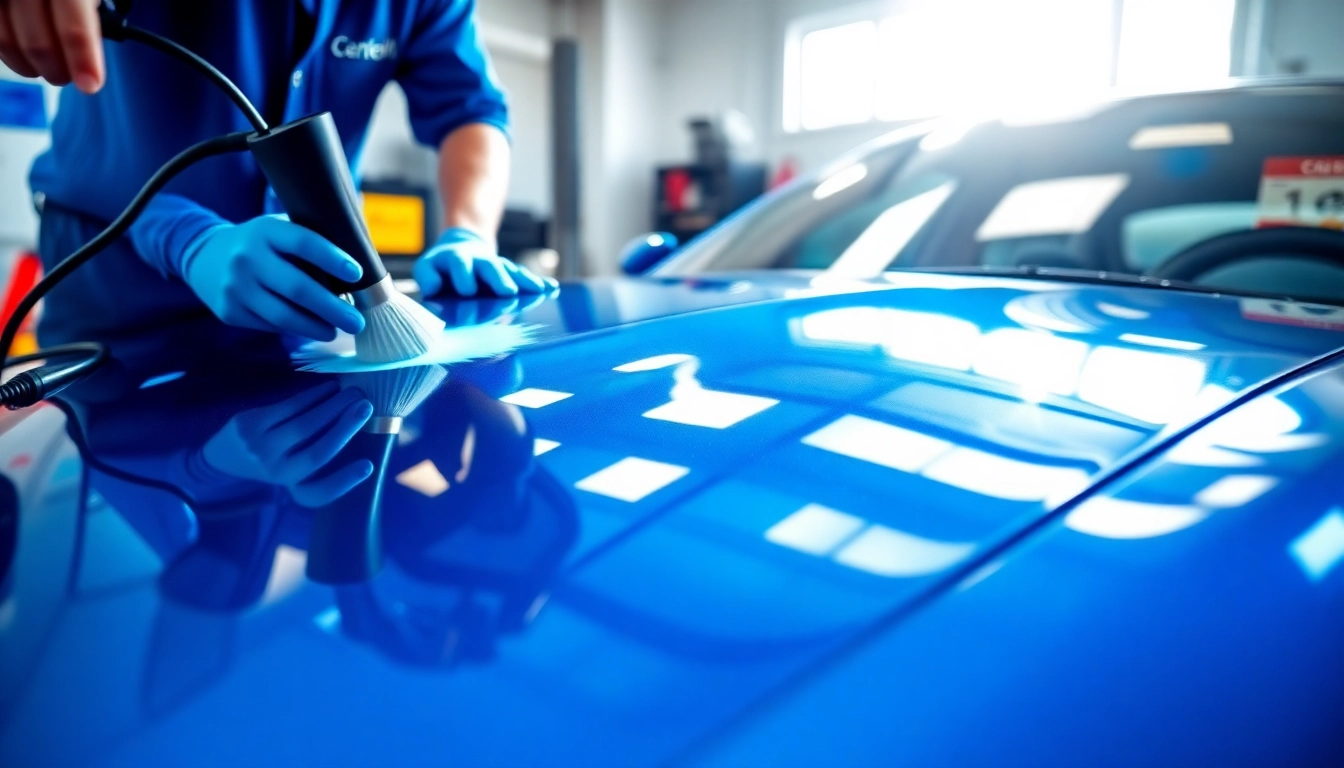Understanding Auto Ceramic Coating
What is Auto Ceramic Coating?
Auto ceramic coating is a liquid polymer applied to the exterior of a vehicle that provides a protective layer against environmental contaminants and damage. This advanced form of nanotechnology bonds with the factory paint, creating a durable shield that repels water, dirt, UV rays, and even minor scratches. Unlike traditional wax or sealants, which wear off over time, auto ceramic coating offers long-lasting benefits, often exceeding several years with proper care.
Benefits of Auto Ceramic Coating
The adoption of auto ceramic coating has surged due to its myriad benefits:
- Durability: Designed to withstand harsh weather conditions, including intense sun and acidic rain.
- Enhanced Appearance: Improves the gloss and depth of your vehicle’s paint, making it look new and vibrant.
- Hydrophobic Properties: Water beads off the surface, preventing water stains and making cleaning easier.
- UV Protection: Acts as a barrier against UV rays, preventing oxidation and fading in your car’s paint.
- Scratch Resistance: Offers better protection against minor scratches and swirl marks compared to traditional waxes.
How Auto Ceramic Coating Works
Auto ceramic coating functions through a chemical bonding process. When applied to the surface of a vehicle, the liquid polymer undergoes a curing process that forms a strong bond with the paint. The microscopic structure of the coating creates a smooth surface that reduces friction, allowing contaminants like dirt, water, and harmful substances to slide off more easily. This technology enables a self-cleaning effect, significantly enhancing the ease of maintenance.
Choosing the Right Auto Ceramic Coating
Top Factors to Consider in Selection
Choosing the right auto ceramic coating involves careful consideration of several factors:
- Type of Vehicle: Different vehicles may require different formulations based on their use and paint type.
- Environmental Conditions: Consider the environment where the vehicle will primarily be used, as some coatings are tailored for specific climates.
- Durability and Longevity: Research how long various products are designed to last and the manufacturer’s claims regarding their durability.
- Application Ease: Some coatings may require professional application, while others can be applied by enthusiasts.
Popular Types of Auto Ceramic Coating
There are several popular types of auto ceramic coatings available, each designed to address specific customer needs:
- SiO2 Coatings: These contain silicon dioxide, providing excellent water-repellent properties and UV resistance.
- Graphene Coatings: An advanced option that enhances durability and resistance to scratches and contaminants.
- Spray Coatings: Easier to apply than traditional coatings, these are ideal for DIY enthusiasts.
Understanding Pricing and Value
The cost of auto ceramic coating can vary significantly based on the product quality, the size of the vehicle, and whether you opt for professional installation. While do-it-yourself kits can be more economical, investing in a professional application often ensures a better result. It’s also essential to weigh the investment against the long-term benefits of protection, maintenance reduction, and the potential increase in resale value.
Application Process of Auto Ceramic Coating
Preparation Steps Before Application
Before applying auto ceramic coating, proper preparation is crucial for achieving optimal results. Follow these steps:
- Wash the Vehicle: Thoroughly wash and dry the vehicle to remove any dirt, grime, or contaminants.
- Clay Bar Treatment: Use a clay bar to eliminate embedded contaminants for a smooth surface.
- Paint Correction: If necessary, perform paint correction to eliminate swirls and scratches that could affect the coating’s appearance and effectiveness.
- Surface Prep Items: Ensure you have all necessary items ready, including gloves, applicators, and microfiber towels.
Step-by-Step Guide to Applying Auto Ceramic Coating
Follow these steps for a reliable application of auto ceramic coating:
- Section Off the Vehicle: Divide the vehicle into manageable sections for effective application.
- Apply the Coating: Using an applicator pad, apply a thin, even layer of the ceramic coating onto the surface, using a cross-hatch motion.
- Let It Cure: Allow the coating to cure according to the manufacturer’s instructions, usually between a few minutes to a couple of hours.
- Buff the Surface: Once cured, use a microfiber towel to buff the surface, enhancing the gloss and eliminating any high spots.
- Repeat: For multiple layers, repeat the application process according to the product guidelines. Multiple layers can enhance durability and protection.
Common Mistakes to Avoid
Even experienced enthusiasts can make errors during application. Here are some common mistakes to avoid:
- Incorrect Weather Conditions: Avoid applying in direct sunlight or extreme temperatures. Ideal conditions are a controlled environment.
- Insufficient Preparation: Skipping the wash and paint correction can result in a less-than-optimal finish.
- Overapplication: Applying too much product can lead to streaks and uneven curing.
Maintaining Your Auto Ceramic Coating
Best Practices for Longevity
To maximize the lifespan of your auto ceramic coating, follow these best practices:
- Avoid Aggressive Cleaning Products: Use a gentle pH-neutral soap for washing.
- Regular Washing: Maintain cleanliness with regular washes, ideally every couple of weeks.
- Keep Away From Harsh Chemicals: Avoid abrasive cleaners and scrubbing pads that could damage the coating.
Cleaning and Care for Coated Surfaces
Proper cleaning techniques can preserve the integrity of the auto ceramic coating:
- Two-Bucket Wash Method: Use one bucket for soapy water and another for rinsing your wash mitt.
- Microfiber Towels: Always use microfiber towels for drying to prevent scratches.
- Periodic Maintenance Products: Consider using maintenance sprays or boosters specifically designed for ceramic coatings to enhance hydrophobic properties.
Assessing Damage and Reapplication Needs
Over time, even the best coatings should be assessed for wear:
- Regular Inspections: Conduct periodic inspections to identify areas requiring reapplication.
- Visual Checks: Look for signs of wear, such as dullness or reduced water beading.
- Reapplication Guidelines: Follow manufacturer recommendations for reapplication timelines, which may be anywhere from one to five years.
Advanced Insights into Auto Ceramic Coating
Comparing Ceramic Coating with Traditional Wax
While traditional wax provides a basic level of protection, it pales in comparison to auto ceramic coating:
- Durability: Ceramic coatings last significantly longer, reducing the frequency of reapplication.
- Protection Level: Ceramic coatings offer better resistance to environmental contaminants, UV rays, and scratches.
- Maintenance: Vehicles coated with ceramic require less maintenance and are easier to clean.
Real-World Cases of Auto Ceramic Coating Success
Real-world applications demonstrate the efficacy of auto ceramic coating:
Case Study 1: A high-end sports car coated with a premium ceramic coating saw a reduction in wash times by 50%, with water and dirt sliding right off the surface.
Case Study 2: A daily driver subjected to harsh weather conditions maintained its original gloss after three years, thanks to the protective coating’s resilience.
Trends in Auto Ceramic Coating Technology
The ceramic coating industry is constantly evolving with new technologies:
- Increased Use of Nanotechnology: Advances in nanotechnology continue to improve the performance and application of coatings.
- Eco-Friendly Formulations: Many manufacturers are developing environmentally-friendly ceramic coatings, reducing harmful chemicals.
- Integration of Hydrophobic Elements: Some recent developments focus on enhancing hydrophobic properties, maximizing the self-cleaning effect.


